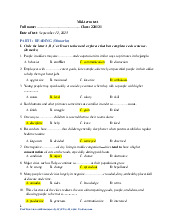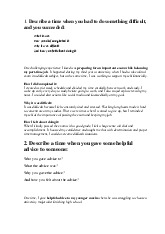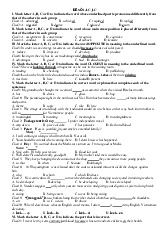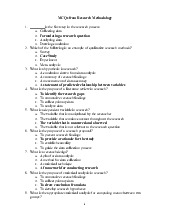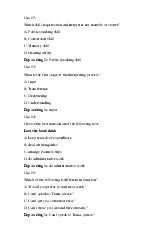



















Preview text:
Câu 1: In which situation is consecutive interpreting often used?
A. Escorting an English speaking group within a large gathering of English speakers
B. Conferences with microphones and headsets and booths for interpreters
C. Conferences in rooms which lack telephonic interpreting facilities. D. Meetings
Vì: Consecutive interpreting is often used in conferences where smaller working
parties meet in rooms which lack telephonic interpreting facilities.
Câu 2: Which skill requires that an interpreter be able to think quickly and “on-their feet”? A. Hearing ability B. Conversion skill C. Memory skill D. Public speaking skill
Vì: Interpreters must be able to think quickly and “on-their feet” as interpreting is an
immediate process, which leaves little margin for thought before action must take place.
Câu 3: How many types of simultaneous interpreting are there? A. 5 B. 4 C. 3 D. 2
Vì: Simultaneous interpreting consists of sight translation, whispered interpretation and electronic hook-up.
Câu 4: How many modes of interpreting are there? A. 3 B. 2 C. 4 D. 5
Vì: There are two main modes of interpreting: consecutive and simultaneous interpreting.
Câu 5: What is used for the temporary storage of segments of speech? A. Acute hearing B. Booths C. Voice D. Memory
Vì: The short-term memory is used for the temporary storage of segments of speech so
that they can be decoded and re-encoded.
Câu 6: What happens during the deciphering?
A. The interpreter gets rid of all the words, retaining the concept, the idea.
B. The concept or idea is now transferred into the other language.
C. The interpreter listens and receives the message.
D. The interpreter finds an equivalent idiomatic expression.
Vì: The deciphering is when the interpreter gets rid of all the words, retaining the concept, the idea.
Câu 7: Choose the most suitable phrase to complete the following text:
I’m a market researcher. I ask people questions and … A. write reports B. write minutes C. sell products D. deal with money
Vì: A market researcher is responsible for asking questions, doing research and writing reports.
Câu 8: Choose the most suitable word to complete the following sentence:
As an office worker, I’m in charge … filing, booking travel for colleagues, and answering phone calls. A. with B. in C. of D. for
Vì: “to be in charge of sth/doing sth” is used to talk about routines that someone does at the workplace.
Câu 9: Complete the sentence:
“Have you got a …? I’d like you to meet Jane.” A. moment B. secretary C. while D. time
Vì: When you want to introduce people, you check if they are free by saying “Have you got a moment?”
Câu 10: Choose the best translation of the following text:
So, you’ve been here for two months now. What different aspects of the job do you cover?
A. Vậy là bạn đã ở đây được 2 tháng rồi. Những khía cạnh khác nhau gì của công việc mà bạn bao trùm?
B. Vậy là bạn đã làm ở đây được 2 tháng rồi. Những khía cạnh khác nhau của công
việc mà bạn làm là gì?
C. Vậy là bạn đã làm ở đây được 2 tháng rồi. Bạn làm những việc gì?
D. Vậy là bạn đã ở đây được 2 tháng rồi. Bạn làm những khía cạnh khác nhau nào của công việc?
Vì: “aspects of the job” is used to refer to job responsibilities, or the routines that
someone does at the workplace.
Câu 1:How many stages are there in the interpreting process? A. 4 B. 5 C. 3 D. 2
Vì: The interpreting process consists of 5 stages: input, understanding, deciphering, transference and output.
Câu 2: How can you improve your memory?
A. Observe the Prime Minister delivering a speech.
B. Ask your friend or family members to translate with you.
C. Ask your friend or family members to interpret an interview for reference.
D. Take an article of suitable length, then try to remember the information and translate it.
Vì: One of the ways to improve your memory is newspaper translation which means
that you take a newspaper article 75-100 words in length and study it for about one
minute; then put the article face down and repeat it as precisely as possible, then translate the article aloud.
Câu 3: Which mode of interpreting is described as the interpreter not waiting for a
speaker to finish a segment and pause before rendering what the speaker is saying?
A. Simultaneous interpreting
B. Unilateral interpreting C. Consecutive interpreting D. Liaison interpreting
Vì: Simultaneous interpreters do not wait for a speaker to finish a segment and pause
before beginning to interpret but follow the speaker and interpret what the speaker is saying.
Câu 4: Which statement is correct?
A. Interpreting deals with spoken words.
B. Interpreting takes place within one language.
C. Interpreting requires writing skill.
D. The interpreter can create his own idea as long as it corresponds the given talk.
Vì: Interpreting is rendering information and ideas from one language into another
language by means of speaking, i.e. interpreting deals with spoken words.
Câu 5: In which situation is consecutive interpreting often used? A. Meetings
B. Conferences in rooms which lack telephonic interpreting facilities.
C. Conferences with microphones and headsets and booths for interpreters
D. Escorting an English speaking group within a large gathering of English speakers
Vì: Consecutive interpreting is often used in conferences where smaller working
parties meet in rooms which lack telephonic interpreting facilities.
Câu 7: Choose the best translation of the following text:
Chúng tôi đảm bảo rằng tất cả hàng hóa đều được đóng gói và dán nhãn phù hợp trước khi được gửi đi.
A. We are sure that all our goods are packed and labelled before dispatched.
B. We make sure that all our goods are properly packed and labelled before they are dispatched.
C. We make sure that all our goods are packed and labelled before they are delivered.
D. We make sure that all our goods are properly packed and labelled before dispatching.
Vì: all other options contain grammar mistakes or convey inadequate information.
Câu 8: Which part of the following text contains a mistake:
Ben is talking to the Sales Manager and Katie is not being in the office today. She is visiting clients. A. visiting B. Sales Manager C. being D. is talking
Vì: the present simple tense of verbs is used to talk about routines and temporary states with the verb “to be”.
Câu 9: Translate the following sentence into English:
Xin giới thiệu với chị, đây là trợ lý mới của tôi, tên là Phương.
A. I’d like to meet Phương, my new PA.
B. I’d like you to meet Phương, my new PA.
C. Please introduce to you my new PA, she’s Phương.
D. Please see my PA, she’s Phương.
Vì: When you introduce people, you say “I’d like you to meet …”
Câu 10: Choose the most suitable word to complete the following sentence:
Career … refers to the period of time away from your job. A. move B. opportunities C. break D. plan
Vì: Career break refers to the period of time away from your job (giai đoạn tạm gián
đoạn/tạm nghỉ công việc)
Câu 1: Choose the correct form of the verb to complete the sentence:
You started two months ago. What different aspects of the job … (you/cover)? A. are you covering B. did you cover C. have you covered D. do you cover
Vì: The present perfect tense of verbs is used to talk about experience.
Câu 2: Which is the best translation of the following text:
Xin anh/chị cho biết anh/chị có từng làm việc trong lĩnh vực sản xuất bao giờ chưa?
A. Could you tell me if you have worked in the production area?
B. Did you work in the production area?
C. Have you worked in the production area before?
D. Please let me know have you worked in the production area?
Vì: The present perfect form of the verb is used to talk about experience, and “could
you tell me if…” is more polite than a direct question.
Câu 3: What kind of information is NOT often included in a job interview? A. Work experience B. Family members C. Name D. Education
Vì: During a job interview there are often questions related to personal contact, work experience and ability.
Câu 4: Which is the best translation of the following text:
Xin chờ một chút. Tôi sẽ nối máy cho bạn.
A. Hold up. I’m connecting you.
B. Hold on. I’ll get you through.
C. Hold through. I’ll get you up.
D. Wait. I’ll connect for you
Vì: “hold on” means “chờ một chút” and “get someone through” means “nối máy cho ai”.
Câu 5: Choose the correct form of the verb to complete the sentence:
I am confident that I have the necessary skills and … for the job. A. experiences B. qualifications C. certifications D. degrees
Vì: “qualifications” means “bằng cấp, trình độ”; skills and qualifications are common
requirements to apply for a job.
Câu 6: Choose the most suitable word to complete the following text:
Now I just want to check your progress here. When did your work … begin? A. position B. responsibilities C. progress D. experience
Vì: “work experience” is a collocation which means “kinh nghiệm làm việc”.
Câu 7: Which word in the following sentence is incorrect:
I work in the reception and I answer the phones and updating the database. A. in B. reception C. updating D. phones
Vì: The correct sentence should be “I answer the phones and update the database”
Câu 8: Choose the most suitable word to complete the following text:
I’m Barbara Szarmach. Could you ask her to call me … before 10 am? It’s urgent. A. again B. soon C. back D. up
Vì: “call some back” means “gọi lại cho ai”
Câu 1: Choose the most suitable word to complete the following text: - What’s her … number? - It’s 19. A. extension B. private C. personal D. desk phone
Vì: “extension number” means “số máy lẻ”.
Câu 2: Which of the following is an offer? A. Could you tell me …? B. Would you let us know … C. Would you like some … D. Can you use this …?
Vì: The structure “Would you like some …” is used to make an offer, “Could you tell
me …?” and “Would you let us know …” are used to make requests, and “Can you use
this …?” is used to ask about ability.
Tham khảo: Unit 1, 1.2 Modes of interpreting
Câu 2: Which mode of interpreting is described as the interpreter not waiting for a
speaker to finish a segment and pause before rendering what the speaker is saying? A. Unilateral interpreting B. Liaison interpreting C. Consecutive interpreting
D. Simultaneous interpreting
Vì: Simultaneous interpreters do not wait for a speaker to finish a segment and pause
before beginning to interpret but follow the speaker and interpret what the speaker is saying.
Câu 3: Which skill requires that an interpreter be able to think quickly and “on-their feet”? A. Hearing ability B. Public speaking skill C. Memory skill D. Conversion skill
Vì: Interpreters must be able to think quickly and “on-their feet” as interpreting is an
immediate process, which leaves little margin for thought before action must take place.
Câu 4: Which statement is correct?
A. The interpreter can create his own idea as long as it corresponds the given talk.
B. Interpreting takes place within one language.
C. Interpreting deals with spoken words.
D. Interpreting requires writing skill.
Vì: Interpreting is rendering information and ideas from one language into another
language by means of speaking, i.e. interpreting deals with spoken words.
Câu 5: What is the first stage of the interpreting process? A. Deciphering B. Input C. Understanding D. Transference
Vì: The interpreting process consists of 5 stages: input, understanding, deciphering, transference and output.
Câu 6: Which mode of interpreting is described as the interpreter rendering after a party has finished speaking? A. Simultaneous interpreting B. Unilateral interpreting C. Bilateral interpreting
D. Consecutive interpreting
Vì: In a consecutive interpreting situation, an interpreter gives a rendering of lengthy
passages of speech after a party has finished speaking.
Câu 9: Complete the sentence:
“Have you got a …? I’d like you to meet Jane.” A. while B. secretary C. moment D. time
Vì: When you want to introduce people, you check if they are free by saying “Have you got a moment?”
Câu 10: Complete the sentence: “Have we … before?” A. seen B. known C. talked D. met
Vì: When you think you know someone who is being introduced to you, you can check
by saying “Have we met before?”.
Câu 11: Choose the most suitable phrase to complete the following text:
I’m a PA. I send emails and letters and … . A. travel B. write reports C. ask people questions D. meet people
Vì: A market researcher is responsible for asking questions, doing research and writing reports.
Câu 15: Which is the function of the following sentence:
Could you let us know your decision as soon as possible? A. An offer B. A request C. Describing ability D. An invitation
Vì: This is a request for a decision using the modal verb “could”. Câu 1:
Which part of the following text is incorrect:
I’m having a new job in the Design Department, and I’m learning lots of new skills. A. I’m having B. Design Department C. lots of D. I’m learning Giải thích kết quả :
Sai. Đáp án đúng là: I’m having
Vì: The present simple tense is used with the verb “to have” that means “to possess/ own”
Tham khảo: Unit 4, 4.1. Developing vocabulary and new skills on office equipment and departments Câu 2:
Choose the most suitable word to complete the following text:
Your staff will often have good ideas and suggestions, so … what they have to say. A. enjoy B. listen to C. respond to D. judge Giải thích kết quả :
Sai. Đáp án đúng là: listen to
Vì: “listen to what they have to say” means “hãy lắng nghe những gì họ muốn nói”
Tham khảo: Unit 4, 4.2. Describing organizational culture at workplace Câu 3:
Which department organizes the maintenance of the office building? A. Facilities B. Finance C. HR D. Production Giải thích kết quả :
Đúng. Đáp án đúng là: Facilities
Vì: The Facilities department organizes the maintenance of the buildings, including office space.
Tham khảo: Unit 4, 4.1. Developing vocabulary and new skills on office equipment and departments Câu 4:
Which department does the following speaker work in? “We maintain good relations with our suppliers”. A. Marketing B. Customer care C. Maintenance D. Purchasing Giải thích kết quả :
Sai. Đáp án đúng là: Purchasing
Vì: The Purchasing department is responsible for buying the materials the company needs to make its products
Tham khảo: Unit 4, 4.1. Developing vocabulary and new skills on office equipment and departments Câu 5:
Choose the most suitable word to complete the following text:
Managers should not think they have to do everything themselves. Instead, they should … tasks to other people. A. push B. give C. delegate D. offer Giải thích kết quả :
Sai. Đáp án đúng là: delegate
Vì: “delegate (sth) to someone” means “giao phó, phân công (công việc) cho ai”
Tham khảo: Unit 4, 4.2. Describing organizational culture at workplace Câu 6: Complete the sentence:
We produce and distribute publicity … such as catalogues and brochures. A. papers B. files C. posts D. materials Giải thích kết quả :
Đúng. Đáp án đúng là: materials
Vì: “publicity materials” means “tài liệu quảng cáo”
Tham khảo: Unit 4, 4.1. Developing vocabulary and new skills on office equipment and departments Câu 7:
Which is NOT a responsibility of a manager? A. answer phone calls B. invest in training courses C. deal with problems
D. communicate with colleagues Giải thích kết quả :
Sai. Đáp án đúng là: answer phone calls
Vì: A manager is responsible for dealing with problems, communicating with
colleagues, investing in training courses and responding to staff’s needs; answering
phone calls is a routine, not a responsibility.
Tham khảo: Unit 4, 4.2. Describing organizational culture at workplace Câu 8:
Which department does the following speaker work in? “We check the quality of the
product at each stage of the manufacturing process”. A. Customer care B. Human resources C. Production D. R&D Giải thích kết quả :
Sai. Đáp án đúng là: Production
Vì: The production department is responsible for making the product
Tham khảo: Unit 4, 4.1. Developing vocabulary and new skills on office equipment and departments Câu 9:
Which department does the following speaker work in? “This week we’re installing
new virus protection on our whole system”. A. Sales B. Facilities C. R&D D. IT Giải thích kết quả : Sai. Đáp án đúng là: IT
Vì: IT means “Information technology”. This department is in charge of the
company’s computers and networks.
Tham khảo: Unit 4, 4.1. Developing vocabulary and new skills on office equipment and departments Câu 10:
Which is the best translation of the following text:
Sếp hỏi tôi tại sao bản báo cáo của tôi vẫn chưa xong.
A. My boss asked me why my report wasn’t ready.
B. My boss asked me why my report isn’t ready.
C. Boss asked me why my report isn’t finished.
D. Boss asked me why isn’t my report finish. Giải thích kết quả :
Đúng. Đáp án đúng là: My boss asked me why my report wasn’t ready.
Vì: The sentence is a reported statement; the other options are not grammatically correct
Tham khảo: Unit 4, 4.2. Describing organizational culture at workplace Câu 2:
Choose the most suitable word to complete the following text:
When your employees are satisfied, they work more effectively, so ... their needs without delays. A. respond to B. deal with C. listen to D. invest in Giải thích kết quả :
Sai. Đáp án đúng là: respond to
Vì: “respond to sth” means “phản hồi/nắm bắt cái gì”
Tham khảo: Unit 4, 4.2. Describing organizational culture at workplace Câu 1:
Choose the most suitable word to complete the following text:
Staff often complained about the new manager, saying that he didn’t … in their abilities. A. develop B. argue C. believe D. agree Giải thích kết quả :
Đúng. Đáp án đúng là: believe
Vì: “believe in someone/sth” means “tin tưởng vào ai/cái gì”
Tham khảo: Unit 4, 4.2. Describing organizational culture at workplace Câu 1:
What is the function of the following sentence:
I'm convinced that staying in London is absolutely necessary. A. Disagreeing B. Agreeing C. Giving opinions D. Making suggestions Giải thích kết quả :
Đúng. Đáp án đúng là: Giving opinions
Vì: The sentence starts with the phrase “I am convinced that”, which is used in giving opinions.
Tham khảo: Unit 5, 5.1. Reacting to different opinions Câu 2:
What is the function of the following sentence:
I'm not sure I agree. I think with e-mail and the Internet we can have enough contact
with the outside world wherever we are. A. Giving opinions B. Making suggestions C. Disagreeing D. Agreeing Giải thích kết quả :
Sai. Đáp án đúng là: Disagreeing
Vì: The sentence starts with “I'm not sure I agree”, which is used in expressing polite disagreements.
Tham khảo: Unit 5, 5.1. Reacting to different opinions Câu 3:
Which phrase is used in rejecting suggestions? A. Why don’t…? B. I’d prefer to ... C. That’s OK, as long as… D. How about …? Giải thích kết quả :
Sai. Đáp án đúng là: I’d prefer to ...
Vì: The structure “I’d prefer to” is used in rejecting a suggestion in a polite way.
Tham khảo: Unit 5, 5.1. Reacting to different opinions Câu 4:
What is the function of the following sentence:
How about introducing special payments to help younger staff buy a house in London? A. Making suggestions B. Disagreeing C. Agreeing D. Giving opinions Giải thích kết quả :
Đúng. Đáp án đúng là: Making suggestions
Vì: The structure “How about + Ving” is used to make suggestions.
Tham khảo: Unit 5, 5.1. Reacting to different opinions Câu 5:
Which is the best translation of the following text:
(1) Cách hiệu quả nhất là quảng cáo trên TV.
(2) Vâng, nhưng lựa chọn này tốn quá. Ngân sách của chúng tôi chỉ có hạn thôi.
A. (1) The most effective way is advertise on TV. (2) Yes, but that’s too expensive. We only have a small budget.
B. (1) The most effective way to advertise is on TV. (2) Yes, that’s too expensive. Our budget is only limited.
C. (1) The most effective way is advertise on TV. (2) Yes, but this option is too
expensive. We only have a small budget.
D. (1) The most effective way to advertise is on TV. (2) Yes, but that’s too expensive. We only have a small budget. Giải thích kết quả :
Sai. Đáp án đúng là: (1) The most effective way to advertise is on TV.(2) Yes, but
that’s too expensive. We only have a small budget.
Vì: The other options contain grammatical mistakes.
Tham khảo: Unit 5, 5.1. Reacting to different opinions, 5.2. Discussing opinions Câu 6:
Which negotiating tip is the speaker adopting when they say:
I asked him exactly what his requirements were, who his current partners were and
how long it would take him to reach a decision. A. Ask a lot of questions
B. Prepare carefully before you negotiate C. Have a lot of options D. Be friendly Giải thích kết quả :
Sai. Đáp án đúng là: Ask a lot of questions
Vì: The speaker is asking many questions with what, who and how.
Tham khảo: Unit 5, 5.1. Reacting to different opinions, 5.2. Discussing opinions Câu 7:
Which negotiating tip is the speaker adopting when they say:
I asked if that was his final offer and he went red in the face.
A. Prepare carefully before you negotiate
B. Pay attention to the other side's body language C. Have a lot of options D. Be friendly Giải thích kết quả :
Đúng. Đáp án đúng là: Pay attention to the other side's body language
Vì: The speaker asked a question and observe the other side’s body language and found that his face came red.
Tham khảo: Unit 5, 5.1. Reacting to different opinions, 5.2. Discussing opinions Câu 8:
Which phrase is used in making concessions? A. How about …? B. That’s OK, as long as… C. Why don’t…?
D. That’s out of the question. Giải thích kết quả :
Đúng. Đáp án đúng là: That’s OK, as long as…
Vì: The structure “as long as” means “miễn là” which is used to make concessions.
Tham khảo: Unit 5, 5.1. Reacting to different opinions Câu 9:
Which is the best translation of the following text:
We should consider billboards. They are one of the fastest growing segments in advertising.
A. Chúng ta nên cân nhắc bảng biển. Họ là một trong những phân khúc phát triển
nhanh nhất trong quảng cáo.
B. Chúng ta cũng nên cân nhắc quảng cáo qua bảng biển. Quảng cáo là một trong
những lĩnh vực phát triển nhanh nhất .
C. Chúng ta nên cân nhắc bảng biển. Họ là một trong những công ty phát triển nhanh nhất trong quảng cáo.
D. Chúng ta cũng nên cân nhắc quảng cáo qua bảng biển. Đó là một trong những phân
khúc phát triển nhanh nhất trong lĩnh vực quảng cáo. Giải thích kết quả :
Sai. Đáp án đúng là: Chúng ta cũng nên cân nhắc quảng cáo qua bảng biển. Đó là một
trong những phân khúc phát triển nhanh nhất trong lĩnh vực quảng cáo.
Vì: The other options violate the principles of translation; the text is an opinion.
Tham khảo: Unit 5, 5.1. Reacting to different opinions, 5.2. Discussing opinions Câu 10:
Which is the presenter talking about:
We’re working on new exciting designs which will reflect a completely new concept. A. Financial information B. Projects C. Staff D. Market position Giải thích kết quả :
Sai. Đáp án đúng là: Projects
Vì: The present continuous tense of the verb (are working) is used to talk about
projects; the phrase “work on”
Tham khảo: Unit 6, 6.1. Vocabulary on presentation, 6.2. structuring a talk. Câu 11:
Choose the best translation for the following text:
Tôi xin trình bày về các chiều của sản phẩm. Sản phẩm này cao 33 cm, dài 18 cm và
rộng 20 cm. Nó có 3 màu: đen, nâu, trắng và giá bán thì rất cạnh tranh.
A. Let me tell you its dimensions. It’s 33 cm high, 18 cm long and 20 cm wide. It
comes in 3 colours: black, brown and white, and the selling price is really competitive.
B. I’d like to talk about the dimensions. It’s 33 cm height, 18 cm length and 20 cm
width. It comes in 3 colours: black, brown and white, and the selling price is really competitive.
C. Let me introduce the dimensions. This product is high 33 cm, long 18 cm and wide
20 cm. It has 3 colours: black, brown and white, and the selling price is really competitive.
D. Let me introduce the dimensions. This product is high 33 cm, long 18 cm and wide
20 cm. It comes with 3 colours: black, brown and white, and the selling price is really competitive. Giải thích kết quả :
Sai. Đáp án đúng là: Let me tell you its dimensions. It’s 33 cm high, 18 cm long and
20 cm wide. It comes in 3 colours: black, brown and white, and the selling price is really competitive.
Vì: The other options contain mistakes of expressing dimensions and colours
Tham khảo: Unit 6, 6.1. Vocabulary on presentation, 6.2. structuring a talk. Câu 12:
Which tip of presentation is the speaker talking about:
“I’m falling asleep. He talks flatly the whole time”.
A. Vary the tone of your voice B. Use humour carefully
C. Outline the structure of your talk D. Use clear visual aids Giải thích kết quả :
Sai. Đáp án đúng là: Vary the tone of your voice
Vì: “talks flatly” refers to no change in the tone of your voice
Tham khảo: Unit 6, 6.2. Structuring a talk. Câu 13:
What does the speaker want to do by saying:
Finally, a few words about our new target market segments. A. introduce new information
B. state the aim of the presentation C. outline the presentation D. end the presentation Giải thích kết quả :
Sai. Đáp án đúng là: end the presentation
Vì: “Finally, a few words about…” is the language structure used to end a presentation
Tham khảo: Unit 6, 6.2. Structuring a talk. Câu 14:
Choose the most suitable word to complete the text:
Another advantage is that it comes … different bright colors like bronze or light green. A. in B. about C. at D. with Giải thích kết quả : Sai. Đáp án đúng là: in
Vì: “come in” is used to talk about colours.
Tham khảo: Unit 6, 6.1 Vocabulary on presentation Câu 15:
Choose the most suitable word to complete the text:
Our … at the close of the year was 140 million euros; that’s an increase of 12% over the previous year. A. share B. asset C. cash flow D. revenue Giải thích kết quả :
Sai. Đáp án đúng là: revenue
Vì: “revenue” means “doanh thu”
Tham khảo: Unit 6, 6.2. Structuring a talk. Câu 1:
